1941 Nickel Coin Value: How Much Is It Worth?
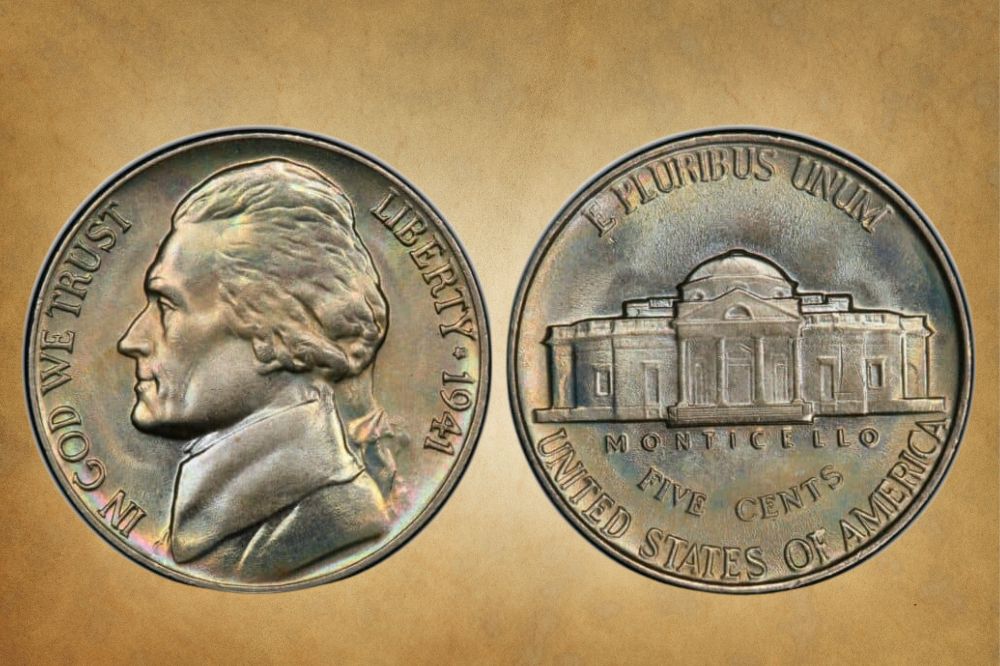
The US Mint started striking Jefferson nickels instead of Buffalo nickels in 1938, and their production has continued to this day. The 1941 Nickel value is atypically high for a five-cent coin because it is in a group of the early, pre-war era series.
Even though three mints produced over 300 million nickel types in 1941, they are collectible nowadays. Unfortunately, intermediate and advanced collectors still don’t appreciate them, but they are excellent pieces for novices and enthusiasts.
1941 nickel value chart |
|||
| Condition | Price | ||
| 1941 No Mint mark Nickel | 1941 D Nickel | 1941 S Nickel | |
| Good | $0.11 | $0.11 | $0.11 |
| Very good | $0.17 | $0.17 | $0.17 |
| Fine | $0.22 | $0.22 | $0.22 |
| Very fine | $0.22 | $0.28 | $0.33 |
| Extra fine | $0.33 | $0.45 | $0.56 |
| AU | $0.56 | $1.71 | $1.71 |
| Mint state 60 | $0.85 | $2.81 | $3.30 |
| Mint state 65 | $13 | $11 | $13 |
| Proof 63 | $107 | / | / |
1941 Nickel Value Guides
The 1941 Jefferson nickel pricing depends on the coin type and preservation level. The next step is to check the number of steps on the reverse since the Full Steps variety is rare and more expensive than a regular strike.
1941 No Mint mark nickel value
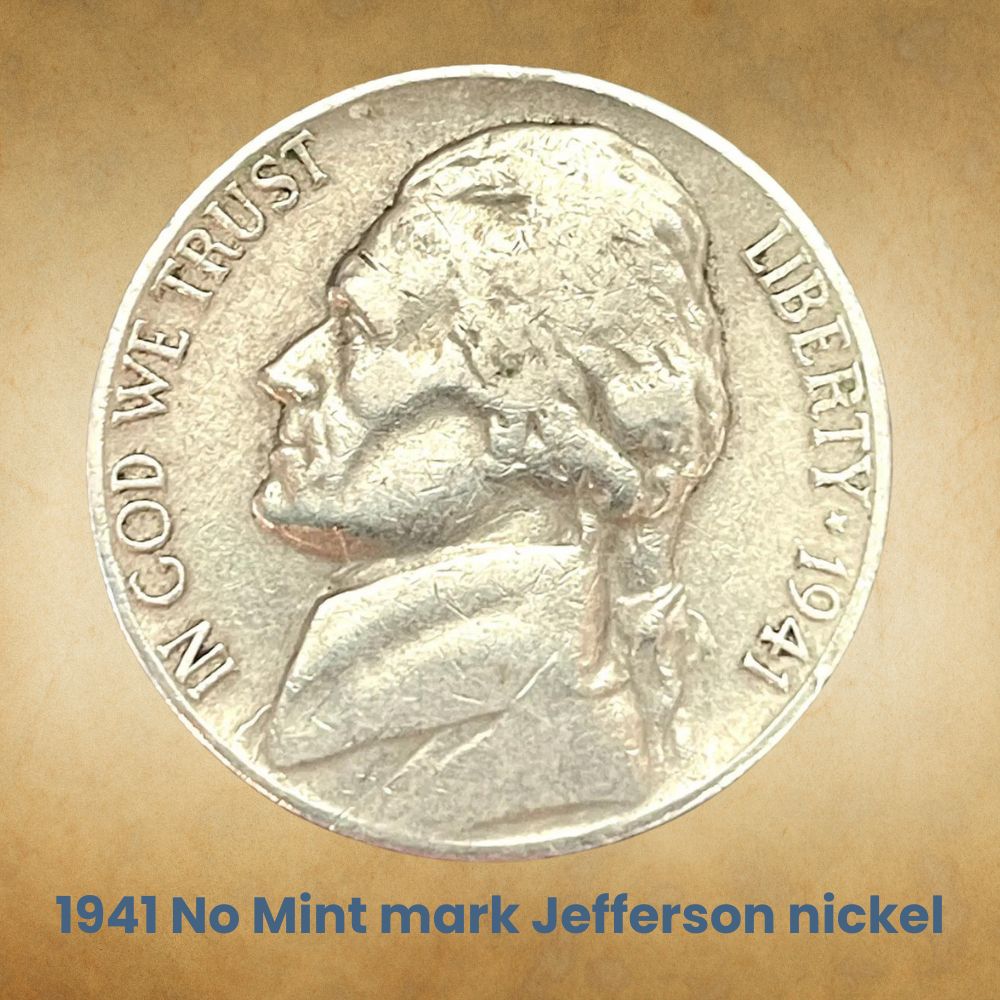
Most 1941 No Mint mark Jefferson nickels of 203,265,000 produced in Philadelphia are worth $0.11 to $13, depending on condition. Even though these copper coins are relatively cheap, those with fully visible 5 to 6 steps can reach $10 to $325.
However, one collector set aside $2,875 for an astonishing 1941 MS 68 Jefferson nickel in 2002 at Heritage Auctions. The unsurpassed auction record won 1941 MS 67 FS Jefferson nickel in 2006. One collector paid $5,175 for this remarkable piece at the Superior Galleries auction.
1941 proof nickel value
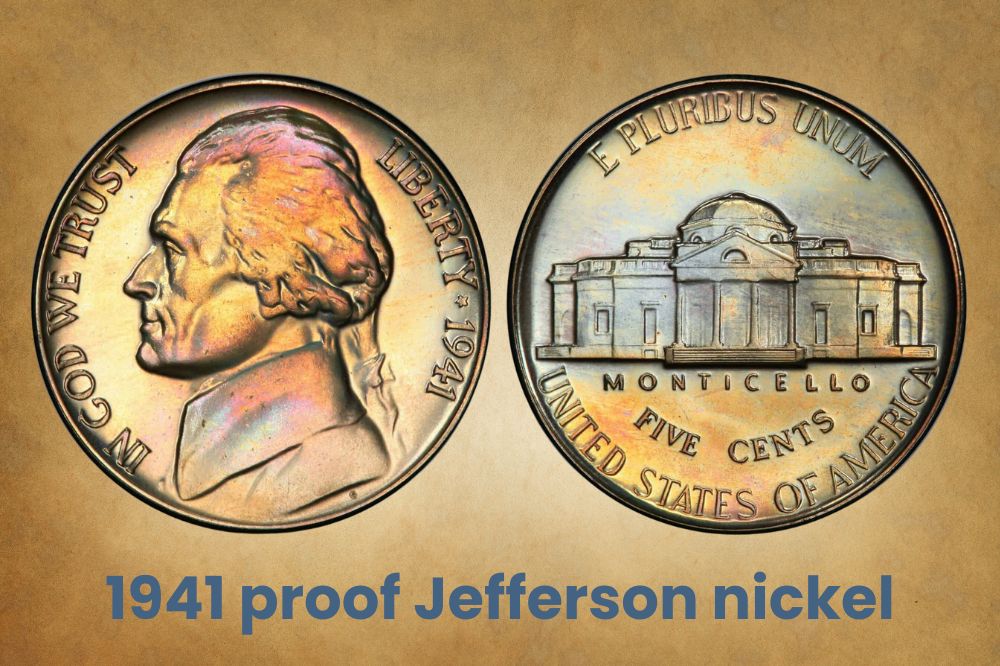
The Philadelphia mint produced a modest number of 18,720 Jefferson nickel proofs in the first war year. The US Mint prepared highly polished planchets and specially prepared dies, allowing each piece to be struck at least twice. Therefore, you can recognize even the tiniest details on these specimens’ surfaces.
1941 proof Jefferson nickel value |
|
| Condition | Price |
| PR 60 | $18 |
| PR 61 | $20 |
| PR 62 | $24 to $30 |
| PR 63 | $28 to $35 |
| PR 64 | $45 to $65 |
| PR 65 | $52 to $70 |
| PR 66 | $99 to $110 |
Nowadays, you can get $18 to $110 per piece, depending on its grade. The most pricey is the 1941 No Mint mark PR 68 Jefferson nickel that reached an impressive $18,800 at Heritage Auctions in 2013.
1941 D nickel value
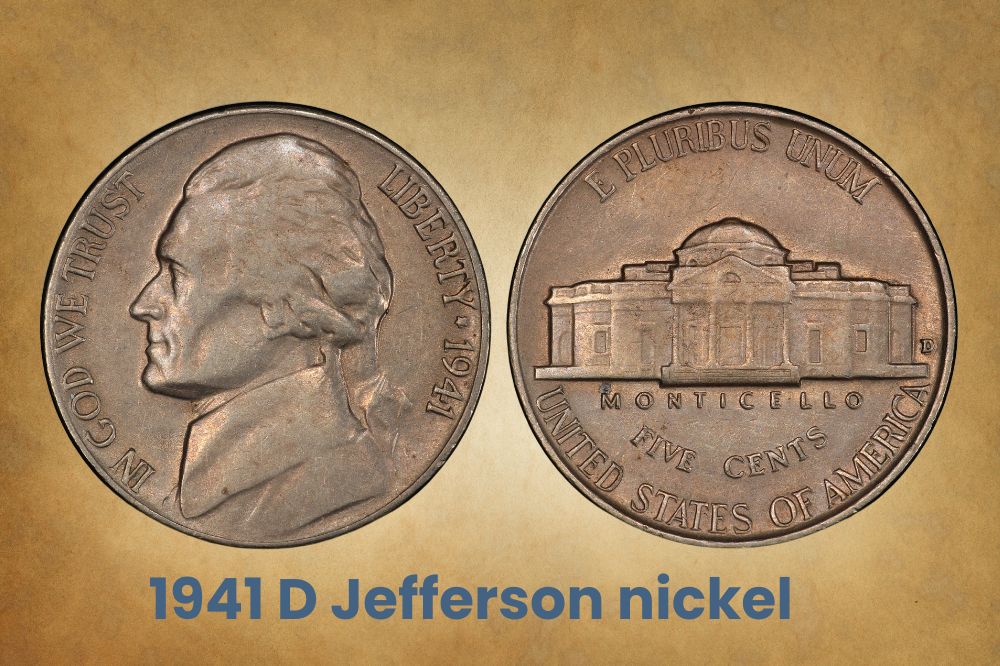
Most of the 53,432,000 Jefferson nickels struck in Denver in 1941 are worth $0.11 to $11, depending on the estimated grade. However, the best pieces with the letter D on the Monticello building’s right side with Full Steps quickly reach $8 to even $5,000.
One of the regular coins with an MS 68 rating won an auction record in 2019 after reaching $9,900 at Heritage Auctions. The one with Full Steps was paid even more. One collector set aside $11,400 for a beautiful 1941 D MS 68 FS Jefferson nickel at Stack’s Bo auction in 2018.
1941 S nickel value
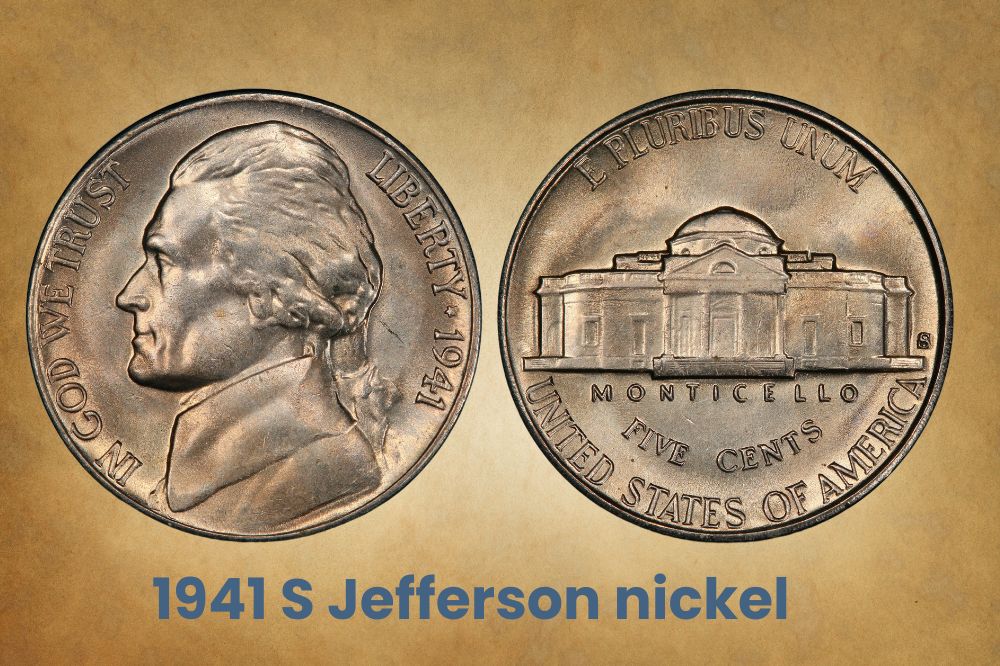
The San Francisco mint had the lowest mintage in the first war year and produced only 43,445,000 Jefferson nickels. You can recognize these coins by the letter S struck next to the Monticello house.
You should pay $0.11 to $13 for one of these pieces, but those with Full Steps are often more costly. Their average price is $28 to $2,400, depending on their condition.
The most expensive 1941 S MS 67 Jefferson nickel was paid $1,900 on eBay in 2022. However, the auction record still holds the coin with Full Steps sold for a fantastic $8,913 at Heritage Auctions in 2006.
1941 Full Steps nickel value
Besides regular coins, you can find a bit scarcer 1941 Full Steps Jefferson nickels on the market. These fully struck specimens are also a part of a circulation strike, but you can recognize at least five visible Full Steps at the Monticello base.
1941 Nickel Full Step value |
|||
| Condition | 1941 No Mint mark FS Nickel | 1941 S FS Nickel | 1941 D FS Nickel |
| MS 64 | $10 | $28 | $8 |
| MS 65 | $25 | $50 | $15 |
| MS 66 | $60 | $170 | $30 |
| MS 67 | $325 | $2,400 | $115 |
| MS 68 | / | / | $5,000 |
*by Greysheet
Only pieces in the mint state without weakly struck steps, traces of planchet problems, and contact marks can be in this highly collectible coin group. They come with 5FS or 6FS designations based on the number of visible complete steps.
All Full Steps nickels are rare, and collectors often pay more for those unique coins when finding them than for regular ones. For instance, you can buy pieces with MS 67 ranking without the mint mark for $325, while the most expensive are those struck in Denver in MS 68 grade. You can get an astonishing $5,000 for such a coin.
Related Posts: 17 Most Valuable Nickel Errors
1941 Nickel Errors
1941 Jefferson nickel off-center error
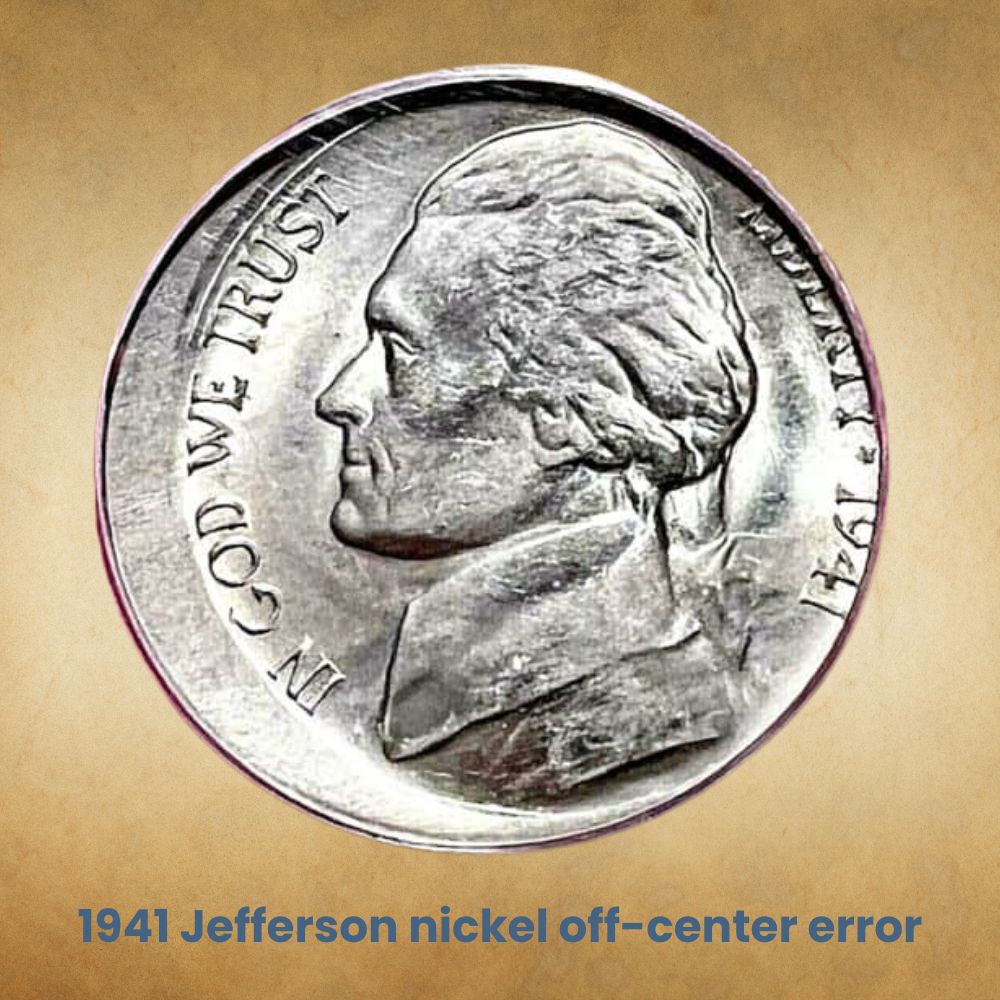
Commonly, the matrix hit 5% to 10% of the design outside the coin center, making an error that could increase such a nickel value. This piece typically costs $8 to $15, but those with 50% of missing design quickly reach $75 to $100+.
1941 Jefferson nickel with re-punched mint mark
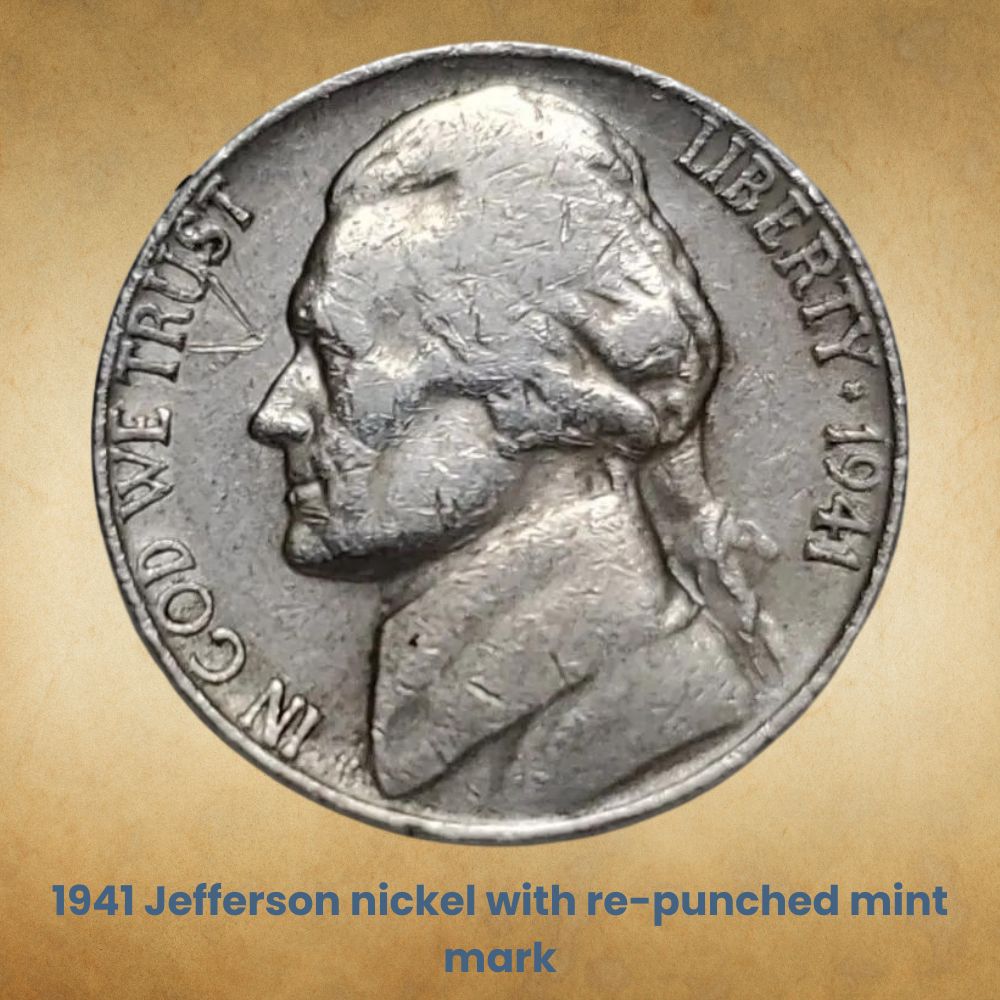
Since workers punched mint marks onto working dies by hand in the early 1940s, many mistakes occurred with small D and S letters. You can find coins with too-faint, sideways, or upside-down initial punches.
After re-punching, workers often caused doubling or tripling letters, but some collectors reported even pieces with quadrupled marks. Most of these coins are worth $3 to $5, but collectors will pay at least $25 for specimens with more drastic errors.
1941 Doubled Die Jefferson nickel
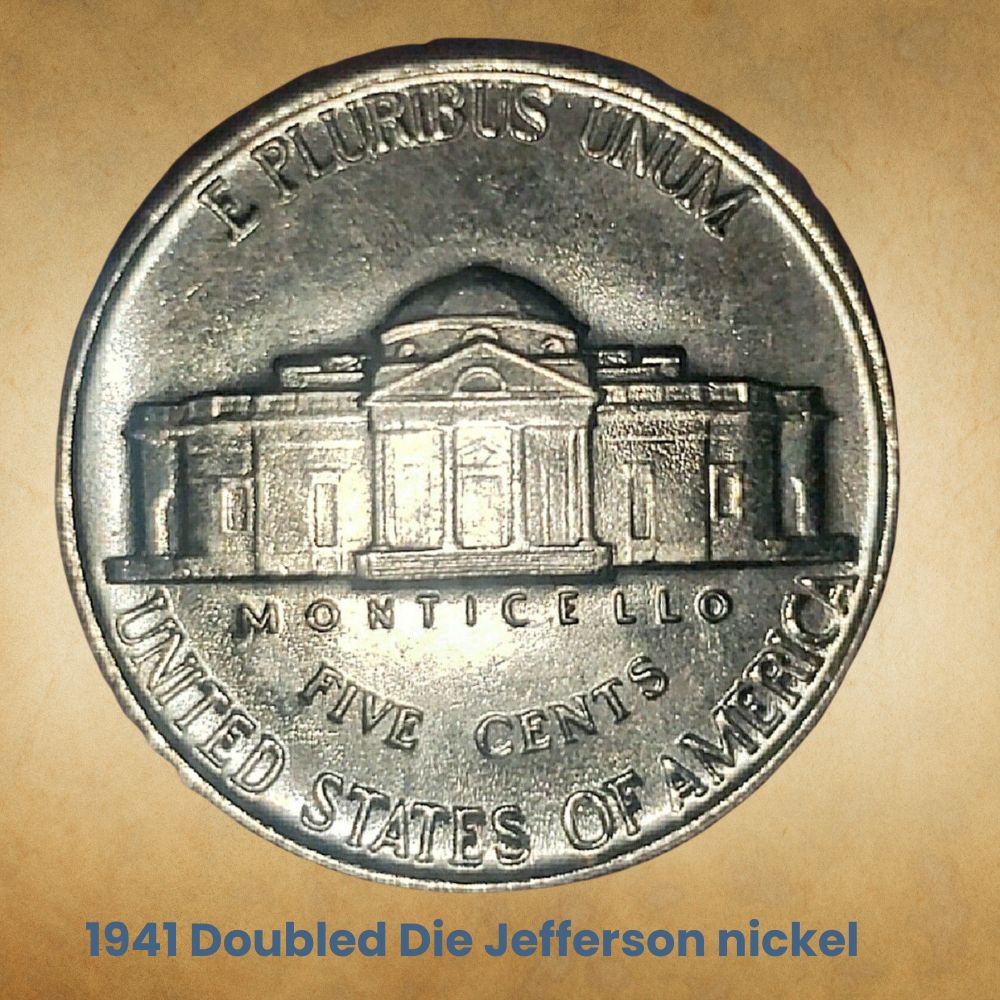
Experts estimate that there are a few 1941 Jefferson nickels with doubling. However, finding an error that stands out or significantly increases the coin value is practically impossible. Most of them will cost as every regular piece available on the market.
1941 Jefferson nickel with Die Cracks
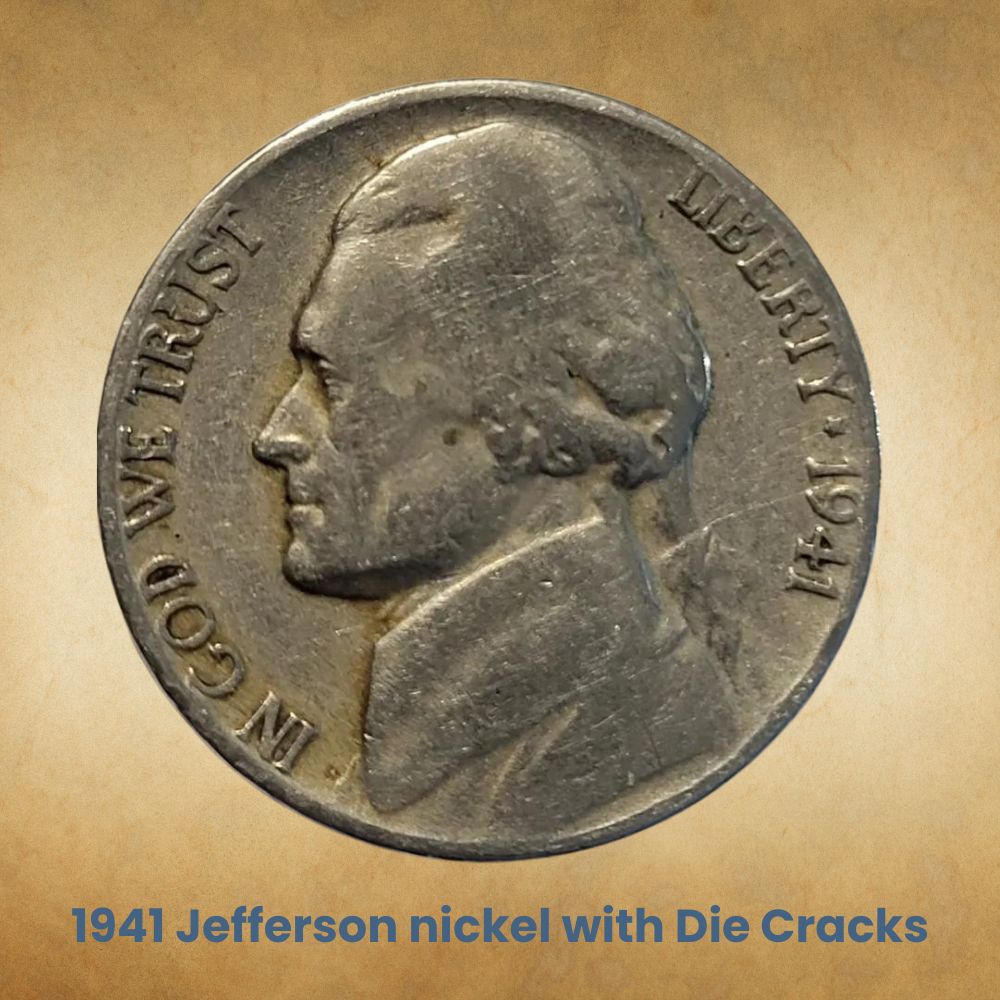
Once planchets used for striking coins became too old, they started cracking. Since these cracks cut into the die surface often remained unnoticed for a while, they started making raised lines on the coin design. These coins’ price range is wide and is typically $1 to $100.
A die cud is the most appreciated die crack type, and you can notice it forming on the coin rim. In most cases, it is a flattish bump attached to the edge. Specimens with the most significant cuds can reach $100 to $150 at auctions.
Related Posts: 19 Most Valuable Nickel Worth Money
History of the 1941 Jefferson Nickel
The first nickels appeared in 1866, and the US Mint has produced this coin type until today, except in three years, 1922, 1932, and 1933. After 25 years of minting, Jefferson nickels replaced the difficult-to-mint Buffalo nickel.
The decision was to make a nickel with the portrait of Thomas Jefferson, one of the Founding Fathers and the 3rd American President. Felix Oscar Schlag created the perfect obverse but had to make extensive corrections to the reverse side and change Jefferson’s house Monticello’s look.
The first minting year was 1938, and this coin design stayed unchanged until 2004. In 2006, the nickel got the new obverse designed by Jamie Franki, but Schlag’s coin reverse look stayed unchanged.
The 1941 Jefferson nickel produced during the first war year was the last one made of copper and nickel before the war ended. Due to the lack of nickel, the US Mint struck Wartime nickels made of copper, silver, and manganese from mid-1942 to 1945.
1941 Jefferson nickel |
||
| Location | Year | Minted |
| Philadelphia | 1941 No Mint mark Nickel | 203,265,000 |
| Philadelphia | 1941 proof Nickel | 18,720 |
| Denver | 1941 D Nickel | 53,432,000 |
| San Francisco | 1941 S Nickel | 43,445,000 |
| Total | / | 300,160,720 |
You can recognize four Jefferson nickel types struck in 1941. The Philadelphia mint produced 203,265,000 coins without the mint mark and 18,720 proofs, or approximately two-thirds of the total 300,160,720 coins produced.
Precisely 53,432,000 nickels came from the Denver mint in 1941, while the San Francisco mint had the lowest mintage that year of only 43,445,000 pieces.
Related Posts: 20 Most Valuable Buffalo Nickels Worth Money
how to identify 1941 Jefferson Nickel?
The obverse of the 1941 Jefferson nickel
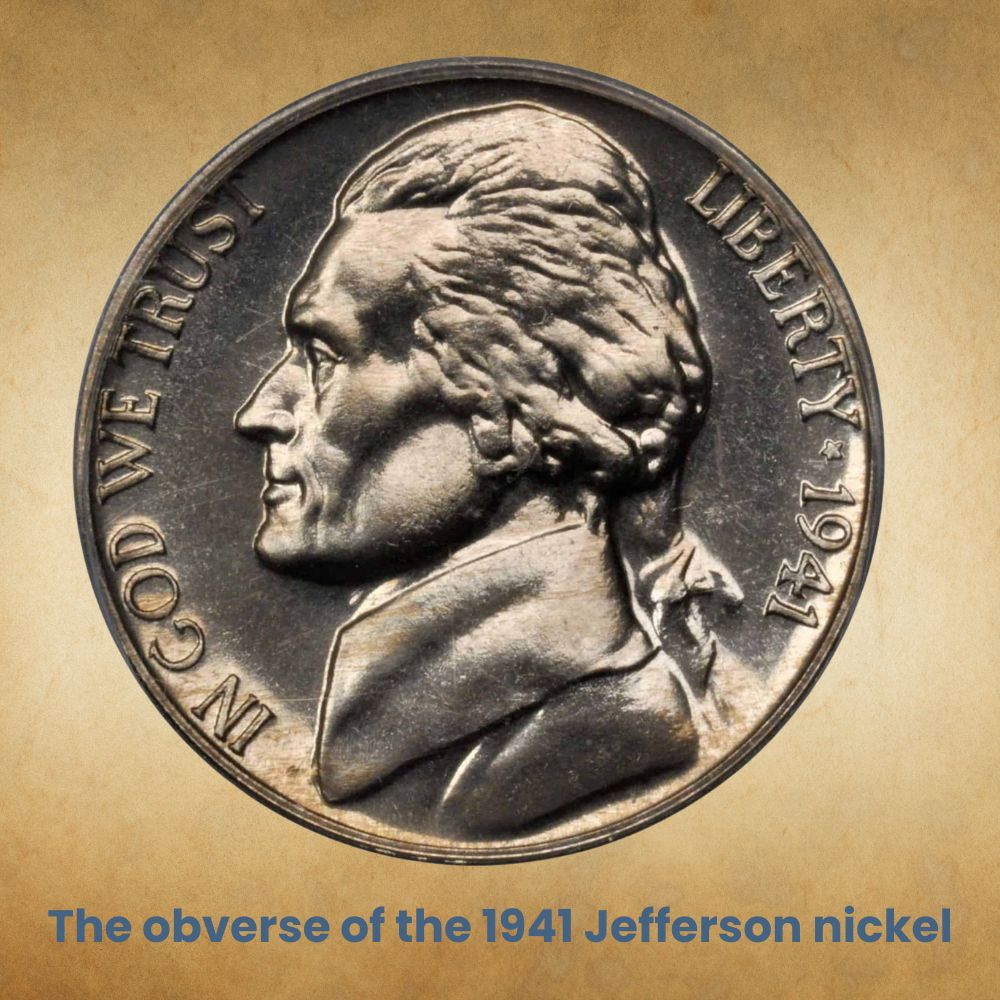
German-born American designer and sculptor Felix Oscar Schlag designed the copper-nickel Jefferson nickel used from 1938 to 2004. On the obverse, you can see a portrait of Thomas Jefferson, the third US President and one of the Founding Fathers.
Besides the President’s profile facing left, you can see inscriptions along the coin obverse. The words IN GOD WE TRUST are on the left side, placed in front of his face, while the coin’s right side is reserved for the date. Above is the most beloved American word LIBERTY, separated from the date by a star.
The reverse of the 1941 Jefferson nickel
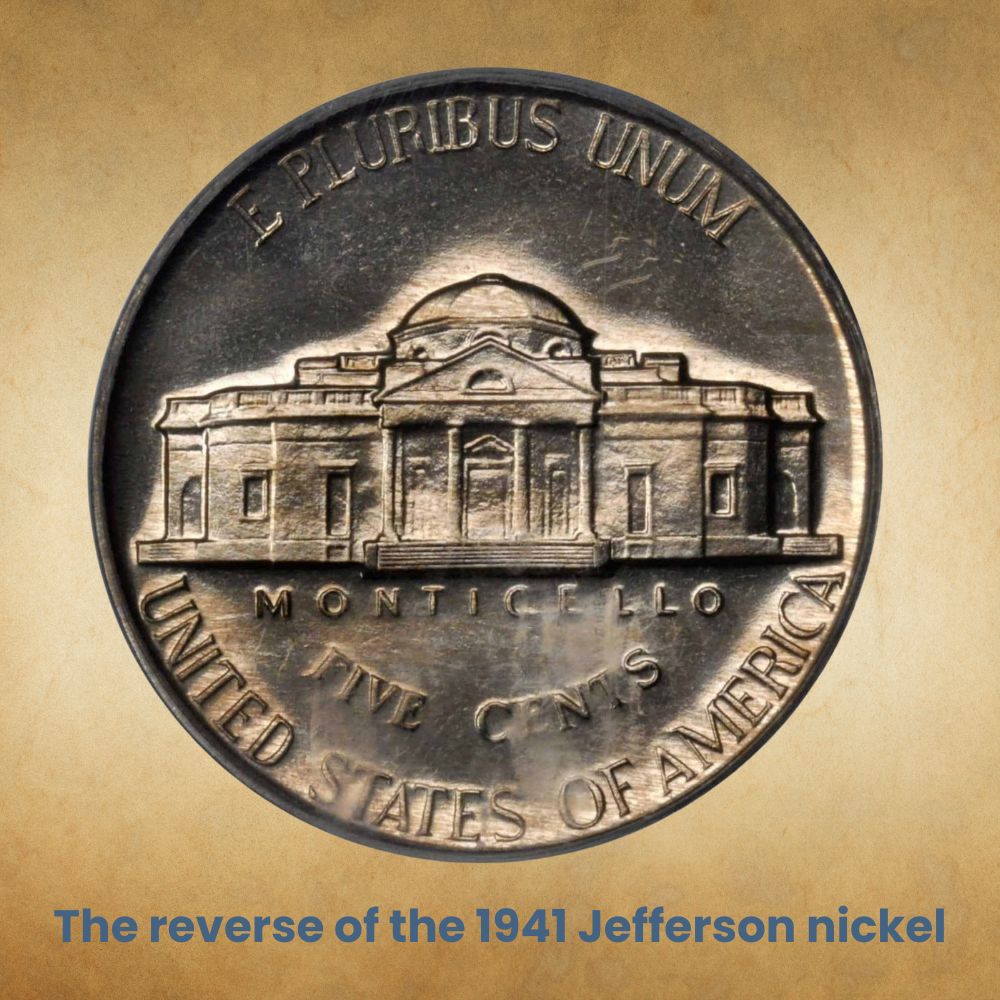
The US Mint organized a competition for a new 5-cent nickel coin design in early 1938, with a prize of $1,000 for the winning project. The primary request was that the historically significant Monticello, Jefferson’s beautiful home in Virginia, dominates on the reverse.
It was the first time for someone besides the Chief Sculptor-Engraver to design one American coin. Even though Schlag won that competition among 390 other contestants, he had to change the reverse side and rotate the house to be seen from the front. However, once revised, this design remained unchanged by 2004.
The Monticello house is in the center, surrounded by the Latin motto E PLURIBUS UNUM on the top coin rim. The bottom part is reserved for the house’s name MONTICELLO, the denomination FIVE CENTS, and the country name, the UNITED STATES OF AMERICA.
Nickels minted in San Francisco and Denver have small letters (S or D) between the Monticello and the right coin rim.
1941 Jefferson nickel |
|
| Face value | 5 cents ($0.05) |
| Compound | 75% copper with 25% nickel |
| Coin weight | 0.17637 ounces (5 g) |
| Coin diameter | 0.83504 inches (21.2 mm) |
| Coin thickness | 0.07677 inches (1.95 mm) |
| Shape | Round |
| Edge | Plain |
Other features of the 1941 Jefferson nickel
The 1941 Jefferson nickel is a 0.17637 ounces (5 g) heavy five-cent coin made of copper and nickel in a 75%: 25% ratio. This rounded, 0.07677 inches (1.95 mm) thick piece with a plain edge has precisely 0.83504 inches (21.2 mm) in diameter.
What makes a 1941 Jefferson nickel rare?
Jefferson nickels with Full Steps are the most scarce and pricey pieces struck in 1941. However, you can also count on premium prices for some errors, including nickels with Die Cracks or off-center errors.
Their prices are often higher than the regular ones and can sometimes reach hundreds or even thousands of dollars.
Which 1941 Jefferson nickels are worth a lot of money?
- 1941 No Mint mark PR 68 Jefferson Nickel that was sold at Heritage auctions for $18,800 in 2013
- 1941 D MS 68 FS Jefferson Nickel that was sold at Stack’s Bowers Galleries auction for $11,400 in 2018
- 1941 D MS 68 Jefferson Nickel that was sold at Heritage Auctions for $9,900 in 2019
- 1941 S MS 67 FS Jefferson Nickel that was sold at Heritage Auctions for $8,913 in 2006
- 1941 No Mint mark MS 67 FS Jefferson Nickel that was sold at a Superior Galleries auction for $5,175 in 2006
- 1941 No Mint mark MS 68 Jefferson Nickel that was sold at Heritage auctions for $2,875 in 2002
- 1941 S MS 67 Jefferson Nickel that was sold on eBay for $1,900 in 2022
How much is the 1941 No Mint mark Jefferson nickel worth?
Most 1941 No Mint mark Jefferson nickels cost $0.11 to $13, depending on their condition. Only proofs are a bit more expensive, and it is possible to find them at approximately $107.
What is the rarest wartime Jefferson nickel?
The rarest pre-war Jefferson nickel is the 1939 P Double Monticello coin worth $200 to $1,000, depending on the condition. The most expensive and rare Jefferson nickel struck during the war is the 1942 D D over D specimen worth $1,500 to $10,000 on the current coin market.
